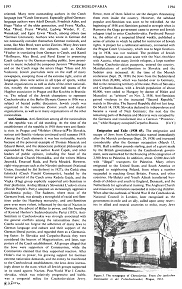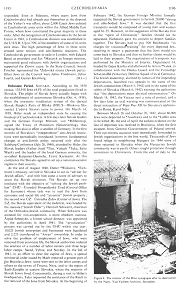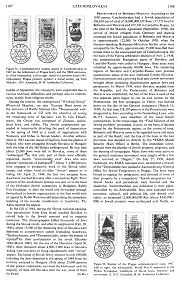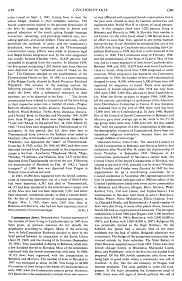<Antisemitism.
Tradition:
Anti-Semitism among all the nationalities of the republic was
of old standing. At the time of the establishment of the
republic in 1918 there were anti-Semitic riots in Prague and
*Hole¨ov (Moravia). In Slovakia, serious anti-Semitic violence
continued until summer 1919. Among the Czech elements it was
less noticeable, mainly because of the personal example of
Thomas Masaryk and Eduard Bene¨, and the democratic political
philosophy as expounded by them, the author Karel Čapek, and
other leaders of public opinion, including the head of the
Czechoslovak Church Hromádka, and the writers Milena Jesenská,
Emanuel Rada, and Pavla Moudrá.
Right parties: However
right-wing groups such as the Národni sjednoceni (National
Union, founded b Jírí Stribrný in 1927), the Česká obec
fa¨istická (Czech Fascist Community), headed by the former
general of the Czech army Radola Gajda, and the Vlajka (Flag)
group explicitly supported anti-Semitism in their platforms.
Andrej Hlinka's Slovenská L'udová strana (Slovak People's
Party) adopted an increasingly aggressive anti-Semitic policy.
Sudeten: The Sudeten,
where most of the Germans lived, was already a stronghold of
racial anti-Semitism under the Hapsburg monarchy, and
anti-Semitism grew even more violent, influences by the rise
of Nazism in Germany, the advent of Hitler to power, and the
founding of Konrad Henlein's Sudetendeutsche Partei [["Sudeten
German Party"]] (1935).
[[Sudeten Germans were bilingual and were the willing servants
to the racist Nazi occupation. So they were absolutely hated
and were driven out at the end of the war in 1945-1946]].
General prejudices:
Anti-Semitism in Czechoslovakia was strongly associated with
the general conflicts among the nationalities there: the
Czechs would not forgive the adherence of many Jews to German
language and culture and their support of the German liberal
parties, and regarded them as a Germanizing factor. In
Slovakia and Carpatho-Russia they were considered the bearers
of Magyarization, and later, supporters of the Czech
establishment. All groups alleged that the Jews were
supporters of Communism, while the Communists claimed that
they supported reaction.
Political aggravation and
refugees: After Hitler's rise to power, his growing
support for German extreme nationalist demands, and the enmity
he manifested to the Czechoslovak establishment, the Jews drew
increasingly closer to the state, which all Jewish groups
supported in its stand against Nazism.
Post-World War I Czechoslovakia, which was relatively
progressive and stable, was a congenial milieu for
Czechoslovakian Jewry. (col. 1193)
Hence, most of them failed to see the dangers threatening them
even inside the country. However, the subdued popular
anti-Semitism was soon to be rekindled [[revived]]. At the
beginning of 1938 anti-Semitism gained in strength when in
Rumania [[Romania]] the Goga government came to power [[for 40
days]] and Jewish refugees tried to enter Czechoslovakia.
Ferdinand Peroutka, the editor of a respected liberal weekly,
published a series of articles in which he called for
restriction of Jewish rights.
A project for a rabbinical seminary, connected with the Prague
Czech University, which was to begin functioning in 1938, was
not realized. The problem of Jewish refugees became even more
acute with the Nazi Anschluss
[[annexation]] with Austria, when many Jewish refugees, a
large number holding Czechoslovakian passports, entered the
country [[and came back from Vienna]]. Manifestations of
anti-Semitism in Slovakia and the Sudeten area increased. At
the time of the Munich conference (Sept. 29, 1938) the Jews
from the Sudetenland (more than 20,000), which was handed over
to Germany, fled to the remaining territory of the state.
Parts of Slovakia and Carpatho-Russia, with a Jewish
population of about 80,000, were ceded to Hungary by decree of
Hitler and Mussolini as "arbiters" on Nov. 2, 1938.
Anti-Semitism gained virulence in the truncated "Second
Republic" mainly in Slovakia.
The second Republic did not last long. On March 14, 1939,
Slovakia declared its independence and became a vassal of Nazi
Germany; the next day the remaining parts of Bohemia and
Moravia were occupied by the Germans and transformed into
German "Protectorate", while Hungary occupied Carpatho-Russia.
[CH.Y.]
Emigration and Exile
(1938-45)
Nazi occupation 1938-1939:
The emigration and escape of Jews from Czechoslovakia started
immediately after the Munich conference (Sept. 29, 1938) and
increased considerably after the German occupation (March 15,
1939). Half a million pound sterling, part of a grant made by
the British government to the Czechoslovak government, were
earmarked for the financing of the emigration of 2,500 Jews to
Palestine.
In addition, about 12,000 Jews left with "illegal" transports
for Palestine. Many others emigrated to the United States and
South America or escaped to neighbouring Poland, from where a
number succeeded in reaching Great Britain, France, and other
countries. He-Halutz and Youth Aliyah transferred hundreds of
children and youth to England, Denmark, and the Netherlands
for agricultural training. The Anglican Church and missionary
institutions succeeded in removing children.
When after the outbreak of World War II the Czechoslovak
National Council in London, later recognized as the
government-in-exile and an ally, called upon army reservists
in allied and neutral countries to enlist, many Jews (col.
1194)
responded. Even in Palestine, where many Jews from
Czechoslovakia had already put themselves at the disposal of
the Yishuv's [[Jewish population in Palestine before 1948]]
war effort, about 2,000 Czech Jews enlisted in Czechoslovak
army units within the Allied Middle East Forces, where Jews
constituted the great majority in these units.
Czech division in the "SU":
After the recognition of Czechoslovakia by the Soviet Union in
1941, a Czechoslovak division was established in the U.S.S.R.
Up to 70% of the members of some of its units were Jews. The
high percentage of Jews in these units created some tension
and anti-Semitic reactions. The Czechoslovak
government-in-exile in London, with Eduard Bene¨ as president
and Jan *Masaryk as foreign minister, maintained good
relations with Jewish organizations and supported the Zionist
cause. In the State Council, Amo¨t Frischer represented the
*´idovská strana (Jewish party). Other Jews on the Council
were Julius Friedmann, Julius Fuerth, and Gustav Kleinberg.
[M.LA.]> (col. 1195)
Holocaust Period.
General: Thousands of
Jews fought in the Czechoslovak armies formed both in the West
and in the Soviet Union during World War II and many worked in
various capacities in Bene¨'s government-in-exile. (col. 1201)
SLOVAKIA. [national-socialist
regime: aryanizations, prohibition of professions and labour
camps]
According to the 1930 census, 135,918 Jews (4.5% of the total
population) lived in Slovakia. The plight of Slovak Jewry
actually began with the establishment of autonomous Slovakia
(Oct. 6, 1938), when the one-party totalitarian system of the
clerical Slovak People's Party of Hlinka (HSL'S - Hlinkova
Slovenská L'udová Strana) came to power.
On March 14, 1939, Hitler made an independent state by causing
the breakup of Czechoslovakia. A few days later Slovak leaders
and the German Foreign Minister, von *Ribbentrop, signed the
Treaty of Protection (Schutzvertrag), thus making Slovakia in
effect a satellite of Germany. In the first months of
Slovakia's "independence" anti-Jewish restrictions were
sporadically introduced; however, fundamental changes in
anti-Jewish policy occurred only after the Salzburg Conference
(July 28, 1940), attended by Hitler, the Slovak leaders
(Father Josef *Tiso, Vojtech *Tuka, Saňo Mach) and the leader
of the local German minority, the so-called Karpaten-Deutsche,
Franz Karmasin. At this conference the Slovaks agreed to set
up a national-socialist regime in their country.
At the end of August 1940, Dieter *Wisliceny, *Eichemann's
emissary, arrived in Slovakia to act as "adviser for Jewish
affairs", and with him came a score of advisers to assist the
Slovak ministries. The Slovaks set up two institutes with the
objective of "solving the Jewish problem":
ÚHÚ - Ústredný Hospodárský Úrad (Central Office for Economy)
whose task was to oust the Jews from economic and social life
and "aryanize" Jewish property;
the second was Ú´ - Ústredňa ´idov (Center of Jews). The Ú´,
the Slovak equivalent of the Judenrat, was headed by the starosta ("Jewish
Elder"), Heinrich Schwartz, chairman of the Orthodox-Jewish
community. When Schwartz was arrested for non-cooperation, a
more obedient starosta,
Árpád Sebestyén, a former school director, was appointed by
the authorities in April 1941.
The "aryanization" process was carried out by the ÚHÚ within
one year: 10,025 Jewish enterprises and businesses were
liquidated and 2,223 transferred to "Aryan" ownership.
[[Hitler bribed with the enterprises the "German friendly"
governments in Europe]]. In order to solve the problem of
employment of Jews, who were removed from economic life, the
Slovak authorities ordered the erection of a number of labour
centers and three large labour camps: Sered, Vyhne, and
Nováky. In the fall of 1941, in an effort to clear the capital
of Jews, a special ministerial order issued by Mach removed a
greater part of the Bratislava Jews; some were sent to the
labour camps and others to the towns of Trnava, Nitra, and to
the region of ¦ari¨-Zemplín in eastern Slovakia, where the
majority of Slovak Jewry lived.
Deportations:
Concurrently, during a visit to Hitler's headquarters, Tuka
requested the assistance of the Reich in the removal of the
Jews from Slovakia. At the beginning of (col. 1195)
February 1942, the German Foreign Ministry formally requested
the Slovak government to furnish 20,000 "strong and
able-bodied Jews". It was decided that the first transports
would be composed of young men and women aged 16-35. However,
on the suggestion of the Slovaks that in the "spirit of
Christianity" families should not be separated. Eichmann gave
his consent to deport families together. The Slovaks had to
pay 500 Reichmarks "as charge for vocational training" for
every deported Jew, receiving in return a guarantee that the
Jews would not come back to Slovakia and that no further
claims would be laid to their property. The organization of
transports was performed by the Ministry of Interior,
Department 14, headed by Gejsa Kanka and afterward by Anton
*Va¨ek, in collaboration with the Hlinka Guard and the
Freiwillige Schutzstaffel (Voluntary Defense Squad of local
Germans).
The Jewish leadership, alarmed by rumours of the impending
deportations, launched two appeals in the name of the Jewish
communities (March 5, 1942) and in the name of the rabbis of
Slovakia (March 6, 1942) warning the authorities that "the
deportations mean physical extermination". On March 14, 1942,
the Vatican sent a note of protest, and a few days later an
oral warning was communicated on the direct instruction of
Pope Pius XII by Slovakia's ambassador to Rome, Karol Sidor.
Between March 26 and October 20, 1942, about 60,00 Jews were
deported to *Auschwitz and to the *Lublin area to be killed
[[probably mass shootings]]. By the end of April the earliest
evidence on the fate of deportees was received in Bratislava,
when the first escapees from General Government of Poland
arrived. Their eye-witness accounts were immediately forwarded
[given]] to Jewish organizations in the free world [[this
world was not free but manipulated by criminal "USA" and it's
industrial belligerent monopolists]]. Thousands of Jews found
refuge in neighbouring Hungary (in 1944 some of them returned
to Slovakia when the Hungarian Jewish community was in peril).
Others sought protection through conversion to Christianity.
From the end of July to the (col. 1196)
middle of September [[1942]] the transports were suspended due
to various technical difficulties and perhaps also to
intercessions, mainly from religious circles.
During the interim, the underground "Working Group"
(Pracovná Skupina; see also "Europa Plan) arose on the
initiative of Rabbi Michael Dov *Weissmandel within the
framework of Ú´ with the objective of saving the remaining
Jews of Slovakia. Led by Gisi Fleischmann, the Group was
composed of ZIonists, assimilated Jews, and rabbis. The Jewish
underground succeeded in temporarily diverting the peril of
deportation in the spring of 1943 as a result of negotiations
with Wisliceny and bribes to Slovak leaders.
Another achievement in 1943 was the rescue of fugitives from
the ghettos of Poland, who were smuggled through Slovakia to
Hungary with the help of the He-Halutz underground. By that
time about 25,000 Jews were left in Slovakia, some of them
"submerged" [[went into hiding]], so that only part of them
were officially registered, mostly "economically vital" Jews
who were granted "certificates of exemption".
About 3-4,000 persons were engaged in productive work in the
Slovak labour camps, and others lived on false "Aryan" papers
or in hiding. On April 21, 1944, the first two escapees from
Auschwitz reached Slovakia after a miraculous flight Their
account of the annihilation process was sent on to the head of
the Orthodox Jewish community in Budapest, Rabbi von
Freudiger, to alert the world and forwarded through
Switzerland to Jewish organizations in the free world with an
appeal by Rabbi Weissmandel demanding the immediate bombing of
the murder installations in Auschwitz. The Allies rejected the
appeal.
[[There was maintained in the appeal that Jews in Auschwitz
were gassed and that there was massive delivery of Jews to the
camp. Both was not right. But other things were right which
were not said at this time: Jews were transported from
Auschwitz and other camps to tunnel systems for Hitler's
underground armament production, and mass death there is still
not completely documentated. Add to this Jews died in masses
in Auschwitz by epidemics, hunger and cold as in other camps.
And Jews died in masses in the Red Army, and in Siberia the
deportees died in masses by cold and hunger. Deported Jews who
were drafted into the Red Army and surviving Jews who were
drafted into the Red Army also mostly died in the fight
against NS troops 1944-1945. At the end of the war Jews also
died in masses in any German concentration camp because of
lack of food and epidemics in the last overcrowded camps]].
In the fall of 1944, during the Slovak national uprising, four
parachutists from Erez Israel reached Slovakia to extend
help to the Jewish remnant and to organize resistance. The Einsatzgruppen killed
thousands of Jews during the Slovak revolt, and after its
suppression (Oct. 28, 1944), about 13,500 of the remaining
Jews of Slovakia were deported to concentration camps
(including Auschwitz, *Sachsenhausen, and *Theresienstadt)
[[and then mostly further to tunnel systems]], under the
pretext or reprisal [[revenge]] for their participation in the
revolt (October 1944-March 1945).
On the eve of the liberation (April 30, 1945), there remained
about 4,000-5,000 Jews in Slovakia hiding with non-Jews or
living clandestinely with "Aryan" papers. The losses of Slovak
Jewry amount to over 100,000, including the Jews deported in
the spring of 1944 from the territory annexed to Hungary. Only
about 25,000 persons of the prewar community survived the
Holocaust and the majority of them left Slovakia after the
war, most of them for Israel.
[LI.RO.]> (col. 1197)
[[This low figure does not seem to be right because there were
many Jews from the camps and tunnel systems who survived and
never came back to Slovakia but directly went to the DP camps
for emigration to Palestine or other overseas countries]].
PROTECTORATE OF
BOHEMIA-MORAVIA. [NS occupations - emigration office and
emigration]
<According to the 1930 census, Czechoslovakia had a Jewish
population of 356,830 out of total of 14,000,000. Of these
117,551 lived in Bohemia and Moravia and 102,542 in
Carpatho-Russia. At the time of the Munich Agreement
(September, 1938), the arrival of Jewish refugees from Germany
and Austria increased the Jewish population in Bohemia and
Moravia to approximately 122,000.
In October 1938, when the German-speaking Bohemian-Moravian
border areas were occupied by the Nazis, approximately 25,000
Jews fled their homes there to the unoccupied part of
Czechoslovakia. On the basis of the Vienna arbitration
decision of Nov. 2, 1938, the predominantly Hungarian parts of
Slovakia and Carpatho-Russia were ceded to Hungary; these
areas were inhabited by approximately 80,000 Jews. The
remaining regions of Slovakia and Carpatho-Russia were granted
autonomous status in the now federated Czecho-Slovakia.
German pressure and a growing local anti-Jewish movement
brought about increasing discrimination against Jews and
persecution.
In March 1939, when Slovakia seceded from the Republic, and
the Protectorate of Bohemia and Moravia was established, the
fate of the Jews in each of the two separate parts began to
run its own course. In the Protectorate, the first synagogue,
in Vsetin, was burned down on the day of the German occupation
(March 15, 1939). At that time 118,310 persons in the
Protectorate were designated as Jews according to the
Nuremberg Laws; only 86,715, however, were members of the
local Jewish communities. In the initial stage, the "Final
Solution of the Jewish problem" proceeded, in part, on the
basis of decrees issued by the Protectorate regime; in the
course of time, Bohemia and Moravia came to be regarded more
and more as part of the Reich, and the fate of the Jews in the
two provinces was decided on directly by the *RSHA (Reich
Security Main Office [["Reichssicherheitshauptamt"]]) in
Berlin. The immediate consequences were the plunder of Jewish
property, pogroms, and the burning of synagogues. Many Jews
who were active in the general resistance movement were caught
while a few Jews survived as "illegals".
On July 27, 1939, Adolf Eichmann, the RSHA representative,
established a branch of the *Zentralstelle für jüdische
Auswanderung (Central Office for Jewish Emigration) in Prague.
The Jews were forced to register for emigration, and divested
of most of their property by a compulsory "Jewish emigration
tax". Jewish books and periodicals were banned and the Juedisches Nachrichtenblatt
[["Jewish News"]] was published in their place controlled by
the Zentralstelle. Jews were excluded from economic, cultural,
and political life, and denied civil rights; an estimated
12,000,000,000 Kčs [[Czech Crowns]] (about $343,000,000) in
Jewish property were confiscated and, finally, an (col. 1198)
order issued on Sept. 1, 1941, forcing Jews to wear the yellow
badge, resulted in their complete isolation.
[[There can be assumed that the local anti-Semitic population
helped a lot to discriminate the Jews]].
[Resistance]
The Jewish communities reacted to the planned elimination of
the Jews by stepping up their activities in Jewish and general
education of the youth, giving foreign language instruction;
retraining; and providing medical care, consulting agencies,
and social welfare. These activities, which prevented the
outbreak of panic and the community's dissolution, were later
continued at the *Theresienstadt concentration camp. Efforts
were made to promote legal and illegal Jewish emigration and,
by the time emigration was totally banned (October 1941),
26,629 persons had succeeded in escaping from the country.
[Deportations]
In October 1939, the first group comprising 1,291 Jewish men
from Ostrava were deported for the "settlement area of
Nisko on the San". The Germans [[and their collaborators]]
decided on the establishment of the Theresienstadt Ghetto on
Oct. 10, 1941, in a secret meeting at the Prague Castle,
chaired by Reich Protector Reinhard *Heydrich. The minutes of
the meeting contain the following passage:
"From this transit camp [Theresienstadt! the Jews, after a
substantial reduction in their numbers, are to be deported to
the East..."
The Jewish communities were ordered to concentrate all the
Jews living in their respective areas into a number of cities
- Prague, Budweis (Budĕjovice), Kolín, Klatovy, Pardubice,
Hradec Králové, Mladá Boleslav, Třebíč, Brno [[Bruenn]],
Olomouc, Ostrava, and Uherský Brod.
In October and November 1941, 6,000 Jews from Prague and Brno
were deported directly to *Lodz and *Minsk. In the period Nov.
24, 1941-March 16, 1945, 73,614 Jews were dispatched to
Theresienstadt in 121 transports. In this period, also 621
Jews were sent to Theresienstadt from towns in the Sudeten
areas ceded to Germany. One of the leaders of Czechoslovak
Jewry, Jacob *Edelstein, was appointed the "elder" of
Theresienstadt.
From Jan. 9, 1942, to Oct. 28, 1944, 60,399 Czech Jews were
deported onward from Theresienstadt to the extermination camps
in the East - Auschwitz, *Majdanek, Minsk, *Riga, *Sobibo,
*Treblinka, and *Zamosc. Only 3,227 of the Jews deported from
Theresienstadt survived the war [[probably with mass death by
diseases and in tunnel systems, and many also survived with
changing identity]]. Following the assassination of Heydrich
on Feb. 19, 1942, a "penal transport" of 1,000 Jews was
deported from Prague to Poland, none of them survived
[[probably with mass death by diseases and in tunnel systems,
and many also survived with changing identity]].
In 1945, 10,090 Jews registered with the Jewish communities,
as returning deportees, out of a total of 80,614 who had been
deported; 6,392 had died in Theresienstadt, 64,172 had been
murdered in the extermination camps, and of the Jews who had
not been deported, 5,201 had either been executed, committed
suicide, or died a natural death.
On the day of the restoration of national sovereignty in
Prague, May 5, 194, there were 2,803 Jews alive in Bohemia and
Moravia, who had not been deported, most of them partners of
mixed marriages.
[E.KU.]> (col. 1199)
 previous
previous



